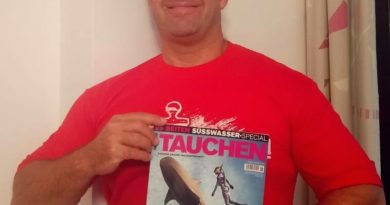Pacificklaus goes Closed Circuit
I have gotten at a point in my diving where I am still enjoying the sheer beauty of the underwater world, but not only. I have also acquired a keen eye for the more subtle things going on on the reef: damselfishes defending their territories; cuttlefish changing their skin coloration in a carefully choreographed mating ritual; shrimp and shrimp-gobies communicating with the nuances of their body language; and sharks spreading thier gills when they arrive at a cleaning station. It’s animal behavior which interests me.
Unfortunately the bubbles caused by exhaling from regular scuba gear cause a lot of disturbances to the marine life! What’s the solution to this unfortunate dilemma: A rebreather. A closed circuit scuba device!

What do “open circuit” and “closed circuit” mean in this context? With normal scuba gear, with a tank and a regulator, you are going to breathe one breath of air (or nitrox or trimix …) in, and then inhale it into the ocean. The breathing gas is lost through the open end of the breathing loop, even though it still contained some oxygen and all of the nitrogen (not used by our bodies). A rebreather fixes this waste:
One question at this point was: Which rebreather to get? There are a number of different rebreathers on the market. In some of them use only one gas and vent excess gas periodically. In the more complex rebreathers, the diver adds a diluent gas and oxygen and bubbles ideally come out only during descent and ascent. There are varying levels of electronic controls and alarm systems in different models.
I believe many of the available units have justification, with the more recreational semi-closed units like the Hollis Explorer fitting the diving needs of people who are eager to dive longer and with fewer bubbles, but without the extra complications of a closed circuit rebreather. I decided to go all out and get a unit which I can use now, and use in the future for challenging, deep technical dives.

I chose the Pelagian, a rebreather manufactured by a Swedish guy in Thailand. It’s a diver controlled closed circuit rebreather – the diver is the one regulating the oxygen partial pressure in the breathing gas. So, oxygen partial pressure should not be an abstract concept to you which you once learned about in your nitrox class. The Pelagian is, to quote my mate David Joyce, a “thinking man’s rebreather”. I am now living in a location where I can get quality training for this unit, have other Pelagian divers nearby, and I got a good deal on a used unit. A Pelagian it was!
I did 6 days of excellent training with my mate Matt Reed at Evolution in Malapaacua. I had to learn some theory and some procedures for rebreather use. The counter-lung are the bags which fill and empty with each breath of the diver. Putting gas into them now influences my buoyancy and the amount of oxygen I am breathing. At the same time, if they are too full or too empty, it’s difficult to take a comfortable full breath. These are quite a few things to juggle at once. It took me a few dives to develop an intuition for this juggle. But once I had that down, rebreather diving became a real pleasure.
The 4th and 5th dives of the course we did at Monad Shoal, the place where the thresher sharks, which have made Malapascua a recognized diving location, convene every morning. These pelagic deep water sharks are eager to get cleaned of parasites by symbiotic wrasses resident at Monad. I’ve been there before, many times; it’s a really cool dive. But this time, without bubbles, it was an unbelievable dive. One of these magic moments nature junkies like me live for! The thresher sharks came up to the top of Monad and circled in front of us and right above us for a good ten minutes. They probably realized on some level that we are there – their big eyes must have picked us up as unusual figures; but we were barely moving, which might have made it harder for them to perceive us. So either they saw us and did not consider us a bubbling nuisance, or they failed to perceive us at all. The sharks were within an arm’s length of myself and came back multiple times. I could identify their sexes, they were so close above me. One of them came back with an open mouth during each pass, to open the way for the cleaner wrasses to its gills. The wrasses were cleaning other fish, like parrot fish, when no shark was around, but immediately turned all their attention to the Masters of Monad when they swam close to their cleaner station. I looked deep into the huge dark eyes of the thresher sharks – it’s rare to catch a look from these aliens of the deep, highly sophisticated, highly evolved vertebrates which split lineages with us more than 400 million years ago.

Before that dive the battery in my camera had run out, but it was an enthralling experience regardless, the unaided direct observation might have made it even more superb. The pictures here are from the dive before when the threshers came equally close, albeit for a shorter time.
I am only starting to contemplate the new photographic and scientific opportunities my rebreather will provide me with. Being so much less obtrusive, and at the same time having so much more bottom time available will allow me to shoot, observe and maybe sample animals in new ways.

